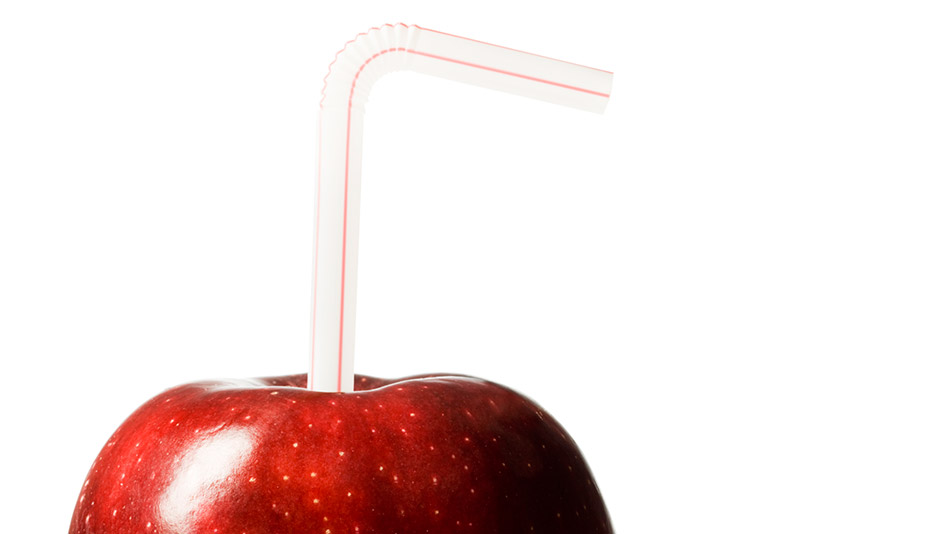
Photo: Rubber Ball/Mike Kemp/Getty Images
Once the stuff of late-night infomercials and fringe health nuts, juices and smoothies have become some of the most popular ways to add more produce to any diet. But you shouldn't treat all spinach-tinged concoctions the same: Both juicing and blending have tasty upsides and less palatable downsides, says Chicago dietitian Dawn Jackson Blatner. We compare the two.
What It Does:
Extracts liquid from produce
Perks:
Fresh pressed juice is like a tastier, easier-to-swallow multivitamin: It lets you consume in one sitting more servings of fruits and vegetables than many people eat in an entire day. And if gastrointestinal issues have you shunning fiber-rich produce, juicing is a smart way to get your vitamins and minerals without too much gas or cramping, says New Orleans dietitian Molly Kimball.
Pitfalls:
While you can jam several pieces of produce into one celery-spinach-collards-apple-ginger drink, you're also concentrating calories and sugar. "If you're juicing three apples, that's roughly 200 calories," says Blatner, author of The Flexitarian Diet. Those three apples also contain about 40 grams of sugar—more than a Snickers bar. Without the fiber contained in the apple's flesh, that sugar can rush into the bloodstream, potentially causing a blood sugar spike and a subsequent crash.
Quick Tip:
According to Blatner, a serving of vegetables can have three to five times fewer calories and far less sugar than fruits, so she suggests you go for at least a 50–50 ratio. And don't let all the green stuff scare you off—Blatner says as little as a half cup of mango can mask the veggie taste in one eight-ounce drink without adding much sugar.
Juicing
What It Does:
Extracts liquid from produce
Perks:
Fresh pressed juice is like a tastier, easier-to-swallow multivitamin: It lets you consume in one sitting more servings of fruits and vegetables than many people eat in an entire day. And if gastrointestinal issues have you shunning fiber-rich produce, juicing is a smart way to get your vitamins and minerals without too much gas or cramping, says New Orleans dietitian Molly Kimball.
Pitfalls:
While you can jam several pieces of produce into one celery-spinach-collards-apple-ginger drink, you're also concentrating calories and sugar. "If you're juicing three apples, that's roughly 200 calories," says Blatner, author of The Flexitarian Diet. Those three apples also contain about 40 grams of sugar—more than a Snickers bar. Without the fiber contained in the apple's flesh, that sugar can rush into the bloodstream, potentially causing a blood sugar spike and a subsequent crash.
Quick Tip:
According to Blatner, a serving of vegetables can have three to five times fewer calories and far less sugar than fruits, so she suggests you go for at least a 50–50 ratio. And don't let all the green stuff scare you off—Blatner says as little as a half cup of mango can mask the veggie taste in one eight-ounce drink without adding much sugar.

Photo: Rubber Ball/Mike Kemp/Getty Images
Blending
What It Does:
Turns solids into liquids, so you're still getting pulp, membranes, and seeds
Perks:
With seeds and pulp comes fiber, nature's appetite suppressant. In fact, research links higher fiber consumption with lower body weight; one small study found that adults at healthy weights consume an average of 33 percent more dietary fiber per day than their obese counterparts do.
Pitfalls:
Thanks to all that fiber, you can't easily swig as many servings of fruits and veggies as you might with juicing, so your total nutrient consumption may be lower. And while a good blender can whip your concoction into a silky, smooth consistency, if you're turned off by pulp, juicing may be the better option.
Quick Tip:
If your smoothies are serving as meal replacements, make sure you're using ingredients that are the highest in protein, fiber and healthy fats to create a wholesome drink. Kimball's recommendation: "I usually suggest aiming for 20 to 35 grams of protein, which provides the equivalent of approximately three to five ounces of lean meat, along with at least five grams of fiber and around five grams of healthy fats."




